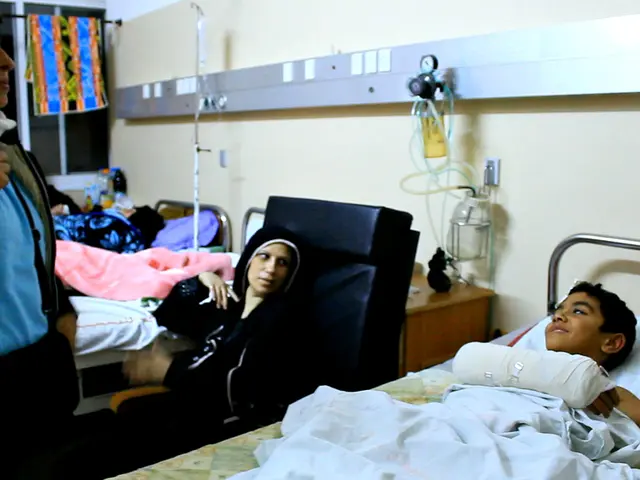Embracing UV Protection from an Early Age: The Importance of Sun Safety for Children
Children's skin is delicate and require extra care to protect them from the harmful effects of the sun. Here are some essential sun safety practices recommended by health organizations to help prevent skin cancer in children.
Firstly, it is important to apply broad-spectrum sunscreen with an SPF of at least 30 generously on all exposed skin, including the face, neck, ears, and tops of feet. Sunscreen should be applied 30 minutes before sun exposure and reapplied every two hours or more often if swimming or sweating.
Dressing children in sun-protective clothing is another crucial step. Sun-protective clothing such as lightweight, long-sleeved shirts and pants made from tightly woven fabric with a UPF rating of 30 to 50+, which blocks 96-98% of harmful UV rays, is recommended. Wide-brimmed hats and UV-protective sunglasses are also recommended to protect the face, neck, eyes, and surrounding skin.
Seeking shade during peak UV hours from 10 a.m. to 4 p.m. is another important practice. Using umbrellas, tents, or canopies to reduce direct sun exposure can help protect children from harmful UV rays.
Avoiding other UV sources such as tanning beds and sun lamps is also essential. These sources increase the risk for skin cancer and should be avoided.
Teaching children about sun safety is important to encourage consistent protective behaviors such as wearing sunscreen and protective clothing, and seeking shade. Explaining the dangers of UV exposure to children can help reinforce the importance of sun safety.
Staying hydrated during outdoor play on hot days is also important to prevent dehydration.
Setting a good example by adults practicing sun safety behaviors themselves is also key to reinforcing these habits for children.
When choosing a sunscreen, it is important to avoid chemicals like oxybenzone, octinoxate, and others that can cause allergic reactions or hormonal disruption. Instead, choose safer broad-spectrum sunscreens.
Sunscreen and lip balm should be applied even on cloudy or hazy days, as UV rays penetrate through clouds.
Applying sunscreen appropriately based on skin type and activity is also important. Using different types (cream, gel, stick, spray) depending on the area and conditions is essential to ensure even coverage. Spray sunscreens require careful application to ensure even coverage.
It is also important to pay attention to the expiration date on sunscreen. Sunscreen should be replaced every year or as directed by the manufacturer.
Babies under 6 months old should be kept out of direct sunlight.
Don't allow teens to use a tanning bed, even for a special occasion. Tanning beds and sun lamps increase the risk for skin cancer.
Encourage others to use safe sun practices to help protect themselves and their loved ones from the harmful effects of the sun.
For more information about sunscreens, visit EWG's Guide to Sunscreens.
It is important to note that relying on sun exposure for producing vitamin D is not a safe method for children. Children should get their vitamin D from a balanced diet or supplements.
By implementing these practices early in childhood, we can help build lifelong habits that reduce the risk of skin damage and skin cancer. These recommendations come from sources including the American Cancer Society, the Skin Cancer Foundation, the American Academy of Dermatology, and pediatric health authorities.
- Sunscreen with an SPF of at least 30 should be generously applied on all exposed skin, as children's skin requires extra protection from the sun.
- Teaching kids about the dangers of UV exposure can help reinforce the importance of sun safety.
- Dressing children in sun-protective clothing with a UPF rating can block 96-98% of harmful UV rays.
- It's crucial to seek shade during peak UV hours, using umbrellas, tents, or canopies to reduce direct sun exposure.
- Avoiding UV sources like tanning beds and sun lamps, which increase the risk for skin cancer, is essential.
- It's important to apply sunscreen on cloudy or hazy days as UV rays can penetrate through clouds.






